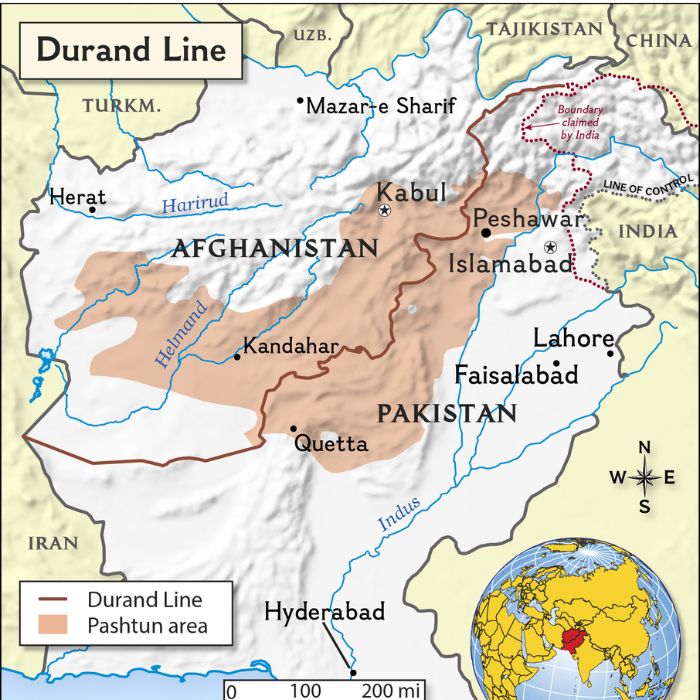Pakistan’s government order expelling all ‘undocumented’ 1.73 million Afghan refugees residing in the country and giving them the choice to leave before the deadline or face arrest and deportation, has ignited a new regional conflict. This conflict is set to escalate into a global humanitarian and security crisis.
This unfolding crisis carries dangerous consequences for the region and the world, as this time, the refugee exodus will bring Pakistani Madrassa-trained jihadist radicalism with it.
The Afghanistan-Pakistan conflict dates back centuries, as hostile elements have consistently crossed into the subcontinent’s western flank, where Pakistan is located today. This hostility can be traced as far back as Muḥammad ibn al-Qāsim’s conquest of Sindh in 712 A.D., or even earlier.
To understand today’s conflict, we must look back to the previous century, specifically during Pakistan’s formation in 1947.
Afghanistan was the only country to vote against Pakistan’s admission to the United Nations. Hostilities have continued since then, marked by a series of frequent armed skirmishes and firefights along the Afghanistan-Pakistan border involving the two armed forces.
The erstwhile British province of North-West Frontier Province (NWFP), now known as Khyber-Pakhtunkhwa Province, has remained a major source of border conflict between the two nations.
This predominantly Pashtun-dominated province, which is Pakistan’s fourth-largest province, as demarcated by the Durand line, has been claimed by Afghanistan as part of the Greater Pashtunistan state. The current Taliban regime in Kabul has continued this rhetoric and even promised to go for a full-fledged war to pursue this claim.
Despite the active support of the Pakistani army and ISI in the Taliban’s takeover of Kabul in August 2021, and Ex-PM Imran Khan glorifying the event as “breaking the chains of slavery”, the newly formed Taliban government has taken a very hostile stance at the borders with Pakistan.
Various reports suggest that border clashes between the two nations rather increased during the current Taliban rule compared to even the US-backed Ghani administration.
Particularly, the two armed forces are frequently engaging in firefights and skirmishes at the border crossings, resulting in civilian and security personnel casualties on both sides. The Taliban justifies its actions as a response to the ill-treatment of Afghan nationals and the Pashtun population by Pakistani security forces during the crossings, which has come to light now, thanks to videos surfacing on social media.
Consequently, many border crossings and trade terminals have been closed by Pakistani forces, causing a heightened state of tension.
To the disappointment of the Pakistani establishment, after the Taliban’s takeover of Kabul, Tehrik-e-Taliban Pakistan (TTP) found a safe haven in Afghanistan, further escalating tensions.
TTP, a radical Jihadi group based in Pakistan which is responsible for some of the deadliest terrorist attacks in the country, including the 2014 Peshawar school massacre, has continued to launch attacks on Pakistani forces and carry out bombings inside Pakistan from their bases in Afghanistan.
The Taliban, however, has rejected these claims and labeled TTP as ‘Pakistan’s problem’.
We need to understand that this conflict is not limited to security forces and border skirmishes; it is deeply rooted in the mutual animosity between the Afghans and Punjabi-dominated Pakistani populations.
Many Pakistanis, especially the Punjabi population, consider Afghans in general and particularly Pashtuns as second-class people. On the other hand, Afghans hold Pakistan responsible for inciting and fueling the deadliest civil wars their country has seen in the last 75 years, causing the deaths and displacement of millions.
This hatred can be seen openly during Cricket matches where not just two national teams clash but even supporters frequently engulf in altercations and fights.
These factors combined have contributed to today’s conflict. According to Pakistani authorities, 14 out of 24 suicide bombings in the nation this year were perpetrated by Afghan nationals.
These claims are substantiated by the fact that TTP has gained significant appeal among Pashtun Afghans living in and around Quetta, the capital city of Baluchistan, which was once a safe hideout for the top leadership of the Afghan Taliban.
These Afghans, who are descendants of refugees displaced during the Communist-Mujahideen Afghan Civil War (1978-92), have been trained in radical Islamist Madrassas. These Madrassas are run by Deobandi and Wahhabi groups with the support of Pakistan and are financed by Saudi Arabia.
The majority of Taliban fighters come from this population, including those who are fighting for TTP.
Amidst this background, Pakistan’s order to expel around 1.7 million ‘undocumented’ Afghans appears to be very illogical, poorly considered, and marked by dangerous consequences.
With Pakistan’s deadline passed and the Taliban promising a strong response, chaos has erupted at the Afghan-Pakistan border. Thousands have already fled in fear of a government crackdown, while many more remain stranded at the border crossings.
Those in Afghanistan are already struggling with food shortages and as chilly winter has begun in Afghanistan, this exodus will worsen the situation. The United Nations has even issued a warning about the potential for a significant humanitarian crisis if this exodus is not halted and those who stayed behind face a government crackdown.
As this conflict unfolds, the Indian subcontinent is on the verge of potentially its largest refugee crisis in the 21st century. This time, however, it won’t be a typical refugee crisis, where a wave of ordinary Afghan refugees seeks shelter and basic livelihood. Instead, it’s expected that many ultra-radicalized refugees will disperse across the region and the world.
As many Jihadi groups are flourishing on Afghan soil, including the Islamic State’s Khorasan faction (ISIS-K) and Al-Qaida, these refugees will be easy entrants for them, easy to brainwash and ready to launch ‘lone-wolf’ attacks in their destination countries.
These potential foot soldiers will not only strengthen these Jihadi-terrorist groups in Afghanistan but also, through low to high-scale terrorist attacks, help them expand their global footprints.
Considering the gravity of the situation, it is important to engage both regional and global stakeholders in preventing this bilateral conflict from evolving into a widespread conflict.
The United States and Saudi Arabia can play a pivotal role in initiating a global dialogue to address this unfolding crisis, most likely under the aegis of the United Nations. Simultaneously, India, in collaboration with Iran, China, Russia, and Central Asian nations, must start a regional strategic dialogue that includes both Pakistan and Afghanistan in the process.
It remains to be seen if the world has genuinely learned lessons from its previous mistakes to take proactive measures to prevent the escalation of this conflict into a global humanitarian and security crisis.






